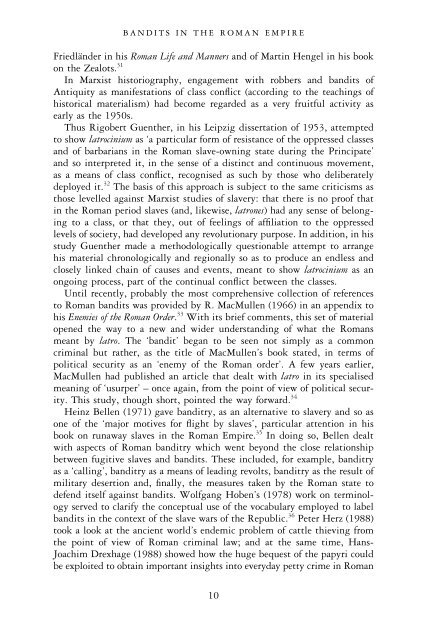You also want an ePaper? Increase the reach of your titles
YUMPU automatically turns print PDFs into web optimized ePapers that Google loves.
BANDITS IN THE ROMAN EMPIRE<br />
Friedländer in his Roman Life and Manners and of Martin Hengel in his book<br />
on the Zealots. 31<br />
In Marxist historiography, engagement with robbers and bandits of<br />
Antiquity as manifestations of class conflict (according to the teachings of<br />
historical materialism) had become regarded as a very fruitful activity as<br />
early as the 1950s.<br />
Thus Rigobert Guenther, in his Leipzig dissertation of 1953, attempted<br />
to show latrocinium as ‘a particular form of resistance of the oppressed classes<br />
and of barbarians in the Roman slave-owning state during the Principate’<br />
and so interpreted it, in the sense of a distinct and continuous movement,<br />
as a means of class conflict, recognised as such by those who deliberately<br />
deployed it. 32 The basis of this approach is subject to the same criticisms as<br />
those levelled against Marxist studies of slavery: that there is no proof that<br />
in the Roman period slaves (and, likewise, <strong>latrones</strong>) had any sense of belonging<br />
to a class, or that they, out of feelings of affiliation to the oppressed<br />
levels of society, had developed any revolutionary purpose. In addition, in his<br />
study Guenther made a methodologically questionable attempt to arrange<br />
his material chronologically and regionally so as to produce an endless and<br />
closely linked chain of causes and events, meant to show latrocinium as an<br />
ongoing process, part of the continual conflict between the classes.<br />
Until recently, probably the most comprehensive collection of references<br />
to Roman bandits was provided by R. MacMullen (1966) in an appendix to<br />
his Enemies of the Roman Order. 33 With its brief comments, this set of material<br />
opened the way to a new and wider understanding of what the Romans<br />
meant by latro. The ‘bandit’ began to be seen not simply as a common<br />
criminal but rather, as the title of MacMullen’s book stated, in terms of<br />
political security as an ‘enemy of the Roman order’. A few years earlier,<br />
MacMullen had published an article that dealt with latro in its specialised<br />
meaning of ‘usurper’ – once again, from the point of view of political security.<br />
This study, though short, pointed the way forward. 34<br />
Heinz Bellen (1971) gave banditry, as an alternative to slavery and so as<br />
one of the ‘major motives for flight by slaves’, particular attention in his<br />
book on runaway slaves in the Roman Empire. 35 In doing so, Bellen dealt<br />
with aspects of Roman banditry which went beyond the close relationship<br />
between fugitive slaves and bandits. These included, for example, banditry<br />
as a ‘calling’, banditry as a means of leading revolts, banditry as the result of<br />
military desertion and, finally, the measures taken by the Roman state to<br />
defend itself against bandits. Wolfgang Hoben’s (1978) work on terminology<br />
served to clarify the conceptual use of the vocabulary employed to label<br />
bandits in the context of the slave wars of the Republic. 36 Peter Herz (1988)<br />
took a look at the ancient world’s endemic problem of cattle thieving from<br />
the point of view of Roman criminal law; and at the same time, Hans-<br />
Joachim Drexhage (1988) showed how the huge bequest of the papyri could<br />
be exploited to obtain important insights into everyday petty crime in Roman<br />
10


